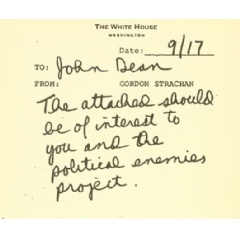President Richard Nixon’s Enemies List, a Collection of Documents, Interviews, and White House Recordings Found at PaperlessArchives.com
"Dealing with our Political Enemies," John Dean wrote on August 16, 1971,"we can use the available federal machinery to screw our political enemies."
President Richard Nixon’s Enemies List, a collection of documents, interviews, and White House recordings, is now available at BACM Research’s PaperlessArchives.com. This collection includes important historical documents that can serve as an important primary source of material for anyone who wants to learn about this important incident in America history.
The entire collection can be downloaded for free at:
http://www.paperlessarchives.com/president-richard-nixons-enemi.html
It’s a collection of documents interviews, , and Nixon’s secret White House audio recordings. They document the creation and development of President Nixon’s so-called list of enemies. The list included individuals thought of by the Nixon White House to be the President’s foremost political opponents.
The list came to life when on June 24, 1971, George T. Bell an assistant to Charles Colson who was the White House’s special counsel, sent a memo to John Dean, the White House counsel. In the memo’s subject line, the words “OPPONENT LIST” was written. There were 20 names compiled in that list along with why they had offended Nixon.
On August 16, 1971, Dean sent out a memo noting the possible use of the federal government’s available machinery to destroy the Administration’s political enemies. From the initial 20, the list grew to become 576 names that include all of Congress’s black members, the staff and supporters of George McGovern, and more.
It was on June 27, 1973, when the public learned of the list’s existence when Dean mentioned it during a Congressional hearing. An interesting event soon occurred when Daniel Schorr, a reporter for CBS obtained a copy of the “Enemies List.” In a live TV program, he read off the listed names and found his name was on it at number 17.
From then on, Nixon’s “Enemies List” becomes an important part of America’s political history. In the collection available at PaperlessArchives.com, anyone seeking to find out more about Nixon’s Enemy’s List of political opponents can learn from the important highlights in the collection. Those highlights include the:
- “White House Nixon Audio Tape” from August 3, 1972
- “Richard Nixon Grand Jury Testimony” on June 26, 1975
- “Senate Hearing Transcript” from June 26, 1973
- “Select Committee On Presidential Campaign Activities of the United States Senate Exhibits”
Now, this collection is available for download at PaperlessArchives.com. It will allow students, professors, politicians, and anyone with interest in politics a primary source to understand this significant incident in American History.
For more information, please visit http://paperlessarchives.com/president-richard-nixons-enemi.html. For inquiries, send an email to press@paperlessarchives.com
( Press Release Image: https://photos.webwire.com/prmedia/2267/227936/227936-1.png )
WebWireID227936
- Contact Information
- Jerry Spencer
- Communications director
- BACM RESEARCH - PaperlessArchives.com
- press@paperlessArchives.com
This news content may be integrated into any legitimate news gathering and publishing effort. Linking is permitted.
News Release Distribution and Press Release Distribution Services Provided by WebWire.
